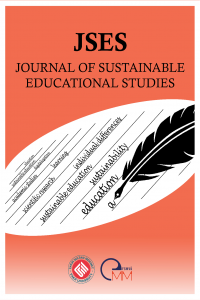Job Satisfaction of Teachers and Predictor Variables For Organizational Commitment
Job Satisfaction of Teachers and Predictor Variables For Organizational Commitment
___
- Balcı, A. (2004). Sosyal bilimlerde araştırma yöntem teknik ve ilkeler. Ankara: Pegem Yayımcılık
- Çokluk, Ö., Şekercioğlu, G., & Büyüköztürk, Ş. (2014). Sosyal bilimler için çok değişkenli istatistik SPSS ve LISREL uygulamaları. Ankara: Pegem Akademi.
- Dağlı, A., & Baysal, N. (2016). Yaşam doyumu ölçeğinin Türkçe’ye uyarlanması: geçerlik ve güvenirlik çalışması. Electronic Journal of Social Sciences, 15(59).
- Diener, E. (1984). Subjective well-being. Psychological Bulletin, 95, 542–575.
- Gündüz, H. (2008). İlköğretim okullarında örgütsel iklim ile öğretmenlerin iş doyumu arasındaki ilişki (Gaziantep ili örneği). Yayınlanmamış yüksek lisans tezi. Gaziantep Üniversitesi Sosyal Bilimler Enstitüsü, Gaziantep.
- Haybron D. M. (2004). Happiness and the importance of life satisfaction. Delivered at the Department of Philosophy, University of Arizona
- Hulpia, H., Devos, G., & Rosseel, Y. (2009). The relationship between the perception of distributed leadership in secondary schools and teachers' and teacher leaders' job satisfaction and organizational commitment. School Effectiveness and School Improvement, 20(3), 291-317.
- Iverson, D. (2000). The relationship between job and life satisfaction. Human Relations, 53(6), 807-839.
- Judge, T. A., & Hulin, C. L. (1993). Job satisfaction as a reflection of disposition: A multiple source causal analysis. Organizational Behavior and Human Decision Processes, 56, 388–421. Kiliç, K. C., Efeoğlu, İ. E., Mimaroğlu, A. G. H., & Özgen, H. (2008). Adana İl’indeki özel sağlık merkezlerinde çalışan personelin iş-aile yaşam çatışmasının örgütsel bağlılık, iş doyumu ve iş stresine etkisi ti bir araştırma. Çukurova Üniversitesi Sosyal Bilimler Enstitüsü Dergisi, 17(2), 241-254.
- Kim-Prieto, C., Diener, E., Tamir, M., Scollon, C., & Diener, M. (2005). Integrating the diverse definitions of happiness: A time-sequential framework of subjective well-being. Journal of Happiness Studies, 6(3), 261–300. doi:10.1007/s10902-005-7226-8.
- Kline, R. B. (2011). Principles and practice of structural equation modeling (3rd ed.). New York: Guilford Press.
- Meador, J. L. (2001). Job satisfaction, perceived organizational support, and organizational commitment: ımplications for teacher turnover in small rural schools. Unpublished doctoral dissertation, Stephen F. Austin State University, Texas.
- Oshagbemi, T. (2000). Satisfaction with co-behavior. Employee Relations, 22(1), 1-16.
- Özdemir, F. (2006). Örgütsel iklimin iş tatmin düzeyine etkisi: Tekstil sektöründe bir araştırma. Yayınlanmamış doktora tezi, Çukurova Üniversitesi, Sosyal Bilimler Enstitüsü, Adana.
- Özden, Y. (1997). Öğretmenlerde okula adanmışlık: Yönetici davranışları ile ilişkili mi? Milli Eğitim, 135, 35-41.
- Özgen, H.,Öztürk, A., & Yalçın, A. (2005). Temel işletmecilik bilgisi (2. Baskı). Adana: Nobel Kitapevi.
- Perry, R. W., L. D., Mankin (2007). Organizational Trust, Trust in the Chief Executive and Work Satisfaction, Public Personnel Management. 36(2).
- Shin, H. S. & Reyes, P. (1995). Teacher commitment and job satisfaction: A causal analysis. Journal of School Leadership, 5 (1), 22-39.
- Simpson, M. J. A. (1993). Comparison of swathing and desiccation of borage (Borago officinalis) and estimation of optimum harvest stage. Annals of applied biology, 123(1), 105-108.
- Tabachnick, B. & Fidel, L.S. (2013). Using multivariate statistics (sixth edition). MA: Allyn&Bacon Inc.
- Türkmen, M , Yıldız, Y, & Çetinöz, F . (2009). Beden eğitimi öğretmenlerinin genel iş doyumu (Manisa örneği). CBÜ Beden Eğitimi ve Spor Bilimleri Dergisi, 4(3), 109-116.
- Üstüner, M. (2009). Teachers’ organizational commitment scale: A validity and reliability study. Inonu University Journal of the faculty of Education, 10(1), 1-17.
- Vandenberg, Robert J., & Scarpello, V. (1994). A longitudinal assessment of the determinant relationship between employee commitments to the occupation and the organization. Journal of Organizational Behavior, 15(6), 535-547.
- Veenhoven, R. (1996). Chapter 1 in: Saris, W.E., Veenhoven, R., Scherpenzeel, A.C. and Bunting B. (Eds.). 'A comparative study of satisfaction with life in Europe. Eötvös University Press, 2, 11-48.
- Yoon, J., & Baker, M.R. (1994). Interpersonel attachment and organizational commitment: Subgroup hypothesis revisited. Human Relations, 47(3), 329-351.
- Başlangıç: 2020
- Yayıncı: Fatih Sultan Mehmet Vakıf Üniversitesi
Gökçen GÖÇEN, Beyza GÜMÜŞ, Cansu KIŞLA, Gülten GÜDEK
Job Satisfaction of Teachers and Predictor Variables For Organizational Commitment
Fen Bilgisi Öğretmen Adaylarının Okul Dışı Öğrenme Kapsamında Müze Eğitimine İlişkin Görüşleri
Zübeyde Burçin GÜRBEY, Hacer EFE, Hatice MERTOĞLU
Aslı Nur İPEK, Fadile Zeynep ÇAVUŞ, Hümeyra SARAÇ
Türkçe Eğitiminde Algısal Dil Becerilerine Yönelik Yapılan Uygulamalar ve Yaşanan Sorunlar
